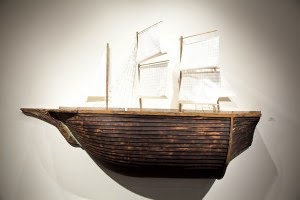Year: 2014
Material: Large, colorful wings, long legs and antennae, compound eyes.
Creator: Nature
Collection: The Academy of Natural Sciences of Drexel University
 |
| More Info |
On any given day, Butterflies! exhibits a living collection of 60
to 150 butterflies that represent 20 to 40 unique species. The museum receives
new butterflies each week, from rainforests and secondary forests across the
world. Butterflies live for one to two weeks, so the collection is in constant flux.
 |
| Do I spy a butterfly or a snake?! |
Compared to the flashy oranges, blues, reds and bold patterns of
some other species, the Owl Butterfly is a bit of a Plain Jane. However, its
earthy brown, black, and yellow coloration and muted markings serve a vital
purpose: protection. See that that
round, marking on its wing that looks like an eye? That’s called an eyespot. In its natural habitat (rainforests of Mexico, Central
and South America), this eyespot might cause an owl butterfly to be mistaken for
a much larger creature. For instance, a lizard (a known predator) in search of a meal might see the
eyespot and think it is looking at the head of a snake, and quickly retreat. Phew! The Owl Butterfly lives another day!
 |
| Eyes? Nope, just colorations on the back of an owl's head. |
The butterfly’s
eyespot is a form of automimicry, where one part of a body looks like, or
visually mimics another part. Not only can automimicry protect
creatures from predators, these visual imitations may also serve to attract or
communicate with mates. Many other creatures use camouflage or automimcry. See that owl photo?
That’s actually the back of the owl’s head.
If you’ve ever been to a zoo or a botanical garden, you probably
know that living collections are “displayed” differently than inanimate
objects. They are often placed within a context or defined space, but their
behavior and positioning within that space is constantly changing. Butterflies
can be found flapping their wings around the room, feasting on bananas at
feeding stations, perched on plants, and resting on walls and the floor (watch
your step!).
Descriptive text and signage is used sparingly within the Butterflies! exhibit, and primarily
serves to
encourage visitors to carefully explore their surroundings. Notice
here how this example poses questions and uses playful language. During my
visit, I was also approached by a staff person, who provided additional
interpretation by pointing out different butterfly species throughout the
space, as well as other creatures, including a poisonous dart frog (don’t
worry, it was enclosed in an aquarium).
 |
| Example of exhibit text |
 |
| Corridor outside of Butterflies! |
 |
| More Info |
 |
| more info |
Earlier this year I read the novel Flight Behavior, by Barbara Kingsolver. Monarch butterflies have a
starring role in the book, which speaks to the issues of climate change, and
how it impacts ecosystems and biodiversity. To further engage visitors with the butterflies, I would create a reading group event around Flight Behavior. The group would visit ANSP,
attend a lecture by a local climate change expert (ideally a scientist from
ANSP or Drexel University), and discuss their responses to the book.
Over the years, my love of living collections has grown from discovering insects in my yard to working in gardens and exploring National Parks. In fact, my interest in these types of "objects," was a driving force in my desire to pursue a master's degree in Museum Education. So, it seems appropriate that this is where I conclude this semester's blog. It's been a great journey. Thanks for considering these objects with me!
Over the years, my love of living collections has grown from discovering insects in my yard to working in gardens and exploring National Parks. In fact, my interest in these types of "objects," was a driving force in my desire to pursue a master's degree in Museum Education. So, it seems appropriate that this is where I conclude this semester's blog. It's been a great journey. Thanks for considering these objects with me!











